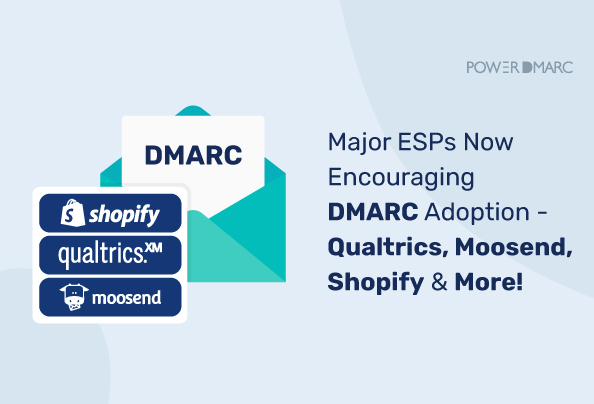We have all heard about the latest Google and Yahoo email authentication requirements, clearly stating that from the 1st Feb 2024, emails that are not DMARC-compliant will suffer in terms of deliverability. This will undoubtedly cause major hindrances in your email marketing campaigns. In hindsight, other email service providers (ESPs) are now rolling out mass marketing emails to their customers, encouraging (and enforcing) DMARC adoption at the earliest to uphold consistent deliverability. Apple Mail’s branded setup is another example of email providers focusing on improved deliverability through authentication.
While this may sound scary, the process is quite simple and you can get compliant in a matter of minutes. Read more to learn how!
Key Takeaways
- Starting February 1, 2024, emails that are not DMARC-compliant will face significant deliverability issues.
- Implementing DMARC, SPF, and DKIM for email authentication can be quick and straightforward.
- Failure to comply with email authentication requirements may result in services like Shopify rewriting sender emails to maintain compliance.
- Ongoing email authentication is essential for sustained deliverability and effectiveness in email marketing campaigns.
- Using a third-party vendor for email authentication can provide valuable support, monitoring, and optimization to meet compliance standards.
DMARC for ESPs: Step-By-Step Implementation Guides
Email Authentication for Non-Compliant Qualtrics Users
Qualtrics supports DMARC, SPF, and DKIM authentication for domain owners, and enabling them will help you meet sender requirements for Google and Yahoo and improve email deliverability for Qualtrics users.
Step 1: Visit your Admin page on the Qualtrics dashboard > Organization Settings > Email > Add domain
Step 2: Enter your domain name, DKIM selector, and a suitable key size (recommended: 2048 bits) and click the Add button
Step 3: Qualtrics generates your custom TXT DKIM record, which you must publish on your DNS to configure the protocol and align your sending source.
Note: All information and images have been taken from the official Qualtrics support guide outlining the configuration steps. You can find it here.
To configure SPF for Qualtrics, you need to include the following mechanism in your SPF record: include:_spf.qualtrics.com
And you’re done! Following this, you can easily configure DMARC for this vendor by creating a DMARC record with the help of PowerDMARC. Contact us to learn more!
Simplify Security with PowerDMARC!
Email Authentication for Non-compliant Shopify Users
Shopify has instructed merchants sending emails from a branded email address to comply with the latest sender requirements by 1st Feb to continue sending emails.
Shopify further informs that failure to take action by the said date will result in Shopify rewriting your sender email to store@shopifyemail.com so that you can continue to send compliant emails without any hindrance.
- On your admin page, navigate to Settings > Notifications
- Click on authenticate your domain under “Sender email”
- Publish the CNAME record on your DNS according to on-page instructions
Finally, you can sign up with PowerDMARC to create your DMARC record easily with our setup wizard and start authenticating your domain.
Email Authentication for Non-compliant Salesforce Users
Salesforce has outlined the following steps to meet compliance requirements for all users sending more than 5000 emails per day:
- Senders must purchase the Salesforce Private Domain or Sender Authentication Page (SAP) solution before the date of enforcement
- Senders must make sure their domain is properly authenticated. Registered domains can get compliant by generating a token in the app switcher and publishing this token as a TXT record in the DNS. You can find the detailed steps here.
Email Authentication for Non-compliant Moosend Users
Moosend (acquired by Sitecore) allows you to authenticate your emails against SPF and DKIM by publishing DNS records in your domain name system to enable the protocols.
Sitecore mentions the following steps for this:
- In your Sitecore account menu, go to More > Settings > Senders
- Choose your sender from the sender list
- Copy the information mentioned in the SPF or/and DKIM tab and follow the instructions to publish the information on your DNS
- Verify your DNS records to ensure your emails are being authenticated
This is barely scratching the surface since many more email service providers have taken to email and the internet to spread awareness of the recent policy changes, and are recommending urgent email authentication implementations to their customer base to stay compliant. Apple Mail’s branded setup is another noteworthy example, emphasizing the importance of authentication in improving email deliverability and branding consistency.
Why Do You Need a Third-Party Domain Security Vendor like PowerDMARC?
Simply implementing email authentication for your vendors is not enough. Email authentication is a lifestyle rather than a one-time configuration and requires ongoing optimization and monitoring to ensure everything is in line. This will ultimately help you meet your email marketing goals in the long run and improve your email deliverability.
To get quantifiable results, PowerDMARC is your best bet! Here’s why:
The Problem
- Difficulty in configuring DMARC, SPF, and DKIM
- Fear of email deliverability issues
- Lack of visibility on sending sources
The Solution We Offer
- Hosted DMARC, SPF, and DKIM for easy setup, monitoring and management
- Human-readable reports for enhanced visibility on email channels
- Real-time human support for expert guidance on best practices
- Fully guided onboarding and training, to facilitate a smooth transition from monitoring to enforced DMARC policies.
Thousands of businesses and leading organizations have relied on our services to comply with the latest industry mandates, and so can you! Start today by taking a free 15-day DMARC trial and take the right step toward compliance.
- What Is Session Hijacking? Types and Protection Tips - November 14, 2025
- What Is an Email Deliverability Checker? Improve Inbox Rates - November 13, 2025
- cPanel SPF, DKIM, and DMARC Setup Guide - November 13, 2025
